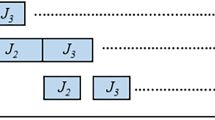Abstract
The response time variability problem (RTVP) is an NP-hard scheduling problem that has been studied intensively recently and has a wide range of real-world applications in mixed-model assembly lines, multithreaded computer systems, network environments and others. The RTVP arises whenever products, clients or jobs need to be sequenced in order to minimise the variability in the time between two successive points at which they receive the necessary resources. To date, the best exact method for solving this problem is a mixed integer linear programming (MILP) model, which solves to optimality most of instances with up to 40 units to be scheduled in a reasonable amount of time. The goal of this paper is to increase the size of the instances that can be solved to optimality. We have designed an algorithm based on the branch and bound (B&B) technique to take advantage of the particular features of the problem. Our computational experiments show that the B&B algorithm is able to solve larger instances with up to 55 units to optimality in a reasonable time.


Similar content being viewed by others
References
Adenso-Díaz, B., & Laguna, M. (2006). Fine-tuning of algorithms using fractional experimental designs and local search. Operations Research, 54, 99–114.
Anily, S., Glass, C. A., & Hassin, R. (1998). The scheduling of maintenance service. Discrete Applied Mathematics, 82, 27–42.
Bautista, J., Companys, R., & Corominas, A. (1997). Modelling and solving the production rate variation problem (PRVP). Top, 5, 221–239.
Bautista, J., Companys, R., & Corominas, A. (2001). Solving the generalized apportionment problem through the optimization of discrepancy functions. European Journal of Operational Research, 131, 676–684.
Bollapragada, S., Bussieck, M. R., & Mallik, S. (2004). Scheduling commercial videotapes in broadcast television. Operations Research, 52, 679–689.
Brusco, M. J. (2008). Scheduling advertising slots for television. Journal of the Operational Research Society, 59, 1363–1372.
Corominas, A., Kubiak, W., & Moreno, N. (2007). Response time variability. Journal of Scheduling, 10, 97–110.
Corominas, A., García-Villoria, A., & Pastor, R. (2008). Solving the response time variability problem by means of multi-start and GRASP metaheuristics. Frontiers in Artificial Intelligence and Applications on Artificial Intelligence Research and Development, 184, 128–137.
Corominas, A., García-Villoria, A., & Pastor, R. (2009). Solving the response time variable problem by means of a variable neighbourhood search algorithm. In: N. Bakhtadze & A. Dolgui (Eds.), Proceedings of 13th IFAC symposium of information control problems in manufacturing (INCOM 2009), Moscow, Russia, June 3–5, 2009. Amsterdam: Elsevier Science. IFAC-PapersOnline.net (ISSN 1474-6670).
Corominas, A., Kubiak, W., & Pastor, R. (2010). Mathematical programming modeling of the response time variability problem. European Journal of Operational Research, 200, 347–357.
Corominas, A., García-Villoria, A., & Pastor, R. (2011). Metaheuristic algorithms hybridized with variable neighbourhood search for solving the response time variability problem. Top. doi:10.1007/s11750-011-0175-y.
Dong, L., Melhem, R., & Mosse, D. (1998). Time slot allocation for real-time messages with negotiable distance constrains requirements. In 4th IEEE real-time technology and applications symposium (RTAS’98), Denver, CO.
Eiben, A. E., Hinterding, R., & Michalewicz, Z. (1999). Parameter control in evolutionary algorithms. IEEE Transactions on Evolutionary Computation, 3, 124–141.
García-Villoria, A., & Pastor, R. (2009). Introducing dynamic diversity into a discrete particle swarm optimization. Computers & Operations Research, 36, 951–966.
García-Villoria, A., & Pastor, R. (2010a). Solving the response time variability problem by means of the electromagnetism-like mechanism. International Journal of Production Research, 48, 6701–6714.
García-Villoria, A., & Pastor, R. (2010b). Solving the response time variability problem by means of a psychoclonal approach. Journal of Heuristics, 16, 337–351.
García-Villoria, A., & Pastor, R. (2010c). Solving the response time variability problem by means of a genetic algorithm. European Journal of Operational Research, 202, 320–327.
García-Villoria, A., Salhi, S., Corominas, A., & Pastor, R. (2011). Hyper-heuristic approaches for the response time variability problem. European Journal of Operational Research, 211, 160–169.
Han, C. C., Lin, K. J., & Hou, C. J. (1996). Distance-constrained scheduling and its applications in real-time systems. IEEE Transactions on Computers, 45, 814–826.
Herrmann, J. W. (2007). Generating cyclic fair sequences using aggregation and stride scheduling (Technical report tr 2007-12). University of Maryland, USA.
Herrmann, J. W. (2011). Using aggregation to reduce response time variability in cyclic fair sequences. Journal of Scheduling, 14, 39–55.
Inman, R. R., & Bulfin, R. L. (1991). Sequencing JIT mixed-model assembly lines. Management Science, 37, 901–904.
Kubiak, W. (1993). Minimizing variation of production rates in just-in-time systems: a survey. European Journal of Operational Research, 66, 259–271.
Kubiak, W. (2009). Proportional optimization and fairness. Berlin: Springer.
Miltenburg, J. (1989). Level schedules for mixed-model assembly lines in just-in-time production systems. Management Science, 35, 192–207.
Monden, Y. (1983). Toyota production systems. Norcross: Industrial Engineering and Management Press.
Pastor, R., & Corominas, A. (2004). Branch and win: OR tree search algorithms for solving combinatorial optimisation problems. Top, 12, 169–191.
Salhi, S., & García-Villoria, A. (2011). An adaptive search for the response time variability problem. Journal of the Operational Research Society. doi:10.1057/jors.2011.46.
Steiner, G., & Yeomans, S. (1993). Level schedules for mixed-model, just-in-time processes. Management Science, 39, 728–735.
Waldspurger, C. A., & Weihl, W. E. (1994). Lottery scheduling: flexible proportional-share resource management. In Proceedings of the 1st USENIX symposium on operating system design and implementation, November 14–17, 1994. Monterey, California.
Waldspurger, C. A., & Weihl, W. E. (1995). Stride scheduling: deterministic proportional-share resource management (Technical Report MIT/LCS/TM-528). Massachusetts Institute of Technology, MIT Laboratory for Computer Science.
Wei, W. D., & Liu, C. L. (1983). On a periodic maintenance problem. Operations Research Letters, 2, 90–93.
Acknowledgements
The authors gratefully acknowledge the support of grants DPI2007-61905 (Ministerio de Educación y Ciencia, Spain, and FEDER) and OGP0105675 (Natural Sciences and Engineering Research Council of Canada Research).
Author information
Authors and Affiliations
Corresponding author
Rights and permissions
About this article
Cite this article
García-Villoria, A., Corominas, A., Delorme, X. et al. A branch and bound algorithm for the response time variability problem. J Sched 16, 243–252 (2013). https://doi.org/10.1007/s10951-012-0277-x
Published:
Issue Date:
DOI: https://doi.org/10.1007/s10951-012-0277-x




